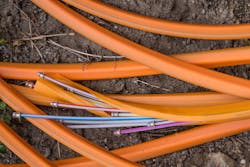Broadband For All
Last week, we began our dive into the broadband sector of the bipartisan Infrastructure Investment and Jobs Act (IIJA), looking at the United States Department of Agriculture (USDA) Broadband program, promising millions of Americans a whole new world with stronger connectivity. This week, we continue our segment with funding from programs included in the IIJA that will help unveil broadband to the entire United States. Many technologies used in the construction of the infrastructure in our country rely on internet. Intelligent Transportation Systems (ITS), electric vehicle charging stations, self-driving vehicles, smart highways, and emergency road services, among others, will all benefit from broadband access as it is unveiled across the country.
Connectivity Programs
According to the Government Finance Officers Association (GFOA), $65 billion in funds are going to be available to states, territories, communities, and stakeholders to implement broadband to the masses, and deliver high-speed, reliable, and affordable internet to all Americans. The additional funding builds off investments in previous laws, including the American Rescue Plan (ARPA) and the Consolidated Appropriations Act of 2021. As a result of the additional funding, the National Telecommunications and Information Administration (NTIA) will implement several new programs.
- Broadband Equity, Access, and Deployment (BEAD) Program: $42.45 billion in funds is intended to support planning efforts including building capacity in state broadband offices, outreach, and coordination with local communities. This program intends to get all Americans online by building infrastructure where needed and increase adoption of high-speed internet. Some eligible uses of funds include planning for deployment of internet, deploying or upgrading internet, installing internet in multi-tenant buildings, and workforce and job training.
- Enabling Middle Mile Broadband Infrastructure Program: $1 billion in funds will help with the construction, improvement, or acquisition of middle mile infrastructure. Middle mile infrastructure refers to the mid-section of Internet infrastructure that carries large amounts of data at high speeds over long distances and connects the “backbone” of the internet infrastructure to the “last mile”, which connects to end users. Eligible uses of funds include construction, improvement, or acquisition of facilities and equipment, engineering design, permitting, and work-related projects, personnel costs, and other costs necessary to the program’s activities. According to the Washington State Transportation Commission (WSTC), these “Middle Miles" will utilize fiber providers who own the fiber routes, towers which house the electronic equipment, small cells that consist of antennas and small radio equipment that can be placed on streetlights, buildings, or poles, and data centers which is a facility that organizations utilize to house their critical application and data, thereby giving broadband to the roads and highways.
- Distance Learning, Telemedicine, and Broadband Program: Reconnect Program: $1.93 billion in grants, direct loans, or a combination of the two will be used to build infrastructure and install equipment that provides modern, reliable high-speed internet service in rural America. The funds can be used for the construction, improvement, or acquisition of facilities and equipment needed to provide broadband service capable of delivering 100 Megabits per second (Mbps) symmetrical service and the acquisition of an existing system not currently providing sufficient access to broadband service.
- Digital Equity Act Programs: This program provides funding to promote digital inclusion and advance equity for all. Eligible uses of funds include developing digital equity plans, making awards to other entities to help make digital equity plans, improving accessibility and inclusivity of public resources, and facilitating the adoption of high-speed internet. It is made up of three sub-programs:
o State Digital Equity Planning Grant Program: $60 million in funds to develop digital equity plans.
o State Digital Equity Capacity Grant Program: $1.44 billion in funds to implement digital equity projects and support the implementation of digital equity plans.
o Digital Equity Competitive Grant Program: $1.25 billion in funds to implement digital equity projects.
Understanding the funding is half the battle, but what does this mean for our highway system? Many organizations can utilize broadband as it is unveiled on our highway systems, giving full connectivity to construction workers, civil engineers, and people who use the roadways daily. All of this helps with traffic, roadside assistance, and we will begin to see a decline in traffic accidents. The connectivity on our highway system will mean more uses for internet across the country, which we will get into in our next installment of the IIJA series. If you’re interested in more information from the IIJA, stay tuned next week for our next installment in our ongoing series, and catch up on our previous IIJA columns here.
---------------------------------
Source: GFOA
